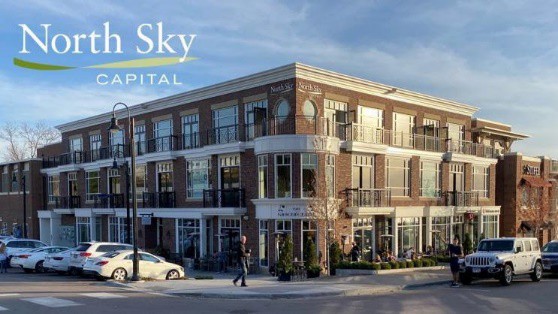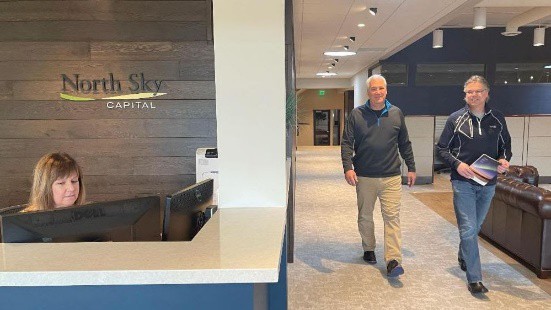Introduction
We are growing. 2021 may be off to a rowdy start but we are feeling confident about the new year here at North Sky. Stock market investors saw significant volatility in Q1—Tesla, Apple and Netflix come to mind—and of course there is the Redditors’ short-squeeze of GameStop that captured national attention in late January and is still ongoing. The flood of new SPAC offerings continues (more on this below). There is a new Administration and a new Congress. Another stimulus package has been passed and infrastructure bills are being considered. Covid vaccines are rolling out, lockdown restrictions are lifting and kids are returning to in-school learning. Some experts are projecting that we will return to normal soon. We certainly hope so!
With all that noise as the backdrop, we are preparing for what could be a breakout year for the firm and the areas in which we invest. We are building on the foundation laid in 2020, which included three new hires, a very strong year in terms of aggregate distributions to our LPs across all funds, our first sustainable infrastructure investments within our Opportunity Zone and New Market Tax Credit strategies and a bigger headquarters that enabled us to bring everyone back into the office in a collaborative yet socially distanced manner in December.
Bringing everyone back together in the office was a HUGE positive. While we had been working effectively from home using MS Teams, almost everything we do—investing, research, analysis, investor relations—is better done as a team and in-person. Based on external feedback, we are several months ahead of many other private investment firms and it shows in our Q4 2020 and Q1 2021 productivity and in the quantity and quality of investment opportunities in the pipeline for our infrastructure and secondaries funds. We are going to keep pressing our advantage in 2021.


New good things are already happening. We are proud to announce that we recently added Dale Freudenberger as an Operating Partner. Dale was the CEO of one of our most successful sustainable infrastructure investments, FLS Energy, and brings more than 15 years of renewable power development and operating experience to our team.
On March 22, our CFO Denise Galvin began transitioning out of her current role into a new senior advisor role and Angie Wood joined as our new CFO. Denise has been in the CFO role for more than 14 years and has been a steady, guiding hand all along. As CEO, I have been the beneficiary of her sage advice on matters large and small. Her advice and stewardship will continue in her new role, but this is an opportune time to acknowledge and thank Denise for her many years of dedicated and professional service to the firm and to our LPs. With nearly 20 years of fund accounting, tax, audit, compliance and other relevant experience, Angie is highly qualified to serve as Denise’s successor as CFO. Prior to joining the team, Angie was at Mill City Capital (another Twin Cities private equity firm), Baker Tilly and PWC.
In our Q2 2021 Market Commentary, we expect to announce the addition of another senior investment professional to our sustainable infrastructure team—someone who will be immediately additive to our deal sourcing and execution capabilities. We will also be adding another investor relations professional to the team in Q2.
One final note before we turn to market conditions for our funds: we are full steam ahead. Our investment pipelines have never been more robust; our ability to source, analyze and execute new investments continues to enhance and expand; and we expect this to be a great year for our sustainable infrastructure and impact secondaries strategies. We hope you will join us in this exciting new chapter of our firm’s growth.
Market Update
Sustainable Infrastructure
Wow, there is a lot to discuss. Our team is growing, market conditions continue to be favorable, we are likely to get a near-term additional policy boost from the new Congress and our pipeline of opportunities is overflowing and diverse—spanning dynamic sectors such as community solar, PACE lending, wastewater recycling/purification, organic waste to renewable natural gas and waste to hydrogen (so called “green hydrogen”).
Following the recent passage of the $1.9 trillion stimulus bill, Congressional leadership has indicated they would like to turn next to a large infrastructure bill. While the details are still coming into focus, we can look to recent House proposals such as the 2020 Moving Forward Act and 2021 CLEAN Futures Act and the Senate Clean Energy and Sustainability Accelerator bill for indications of what national legislation may contain. In addition to major carbon reduction mandates for utilities and transportation, and building energy efficiency requirements, notably both the House and Senate proposals call for the creation of a new green infrastructure bank meant to grow to over $800 billion in assets over 10 years. We believe it’s likely this concept survives into final legislation and will create new opportunities to invest capital in public private partnerships alongside the new bank.
It is also possible that a refundable investment tax credit (ITC) program will be reinstated similar to the one created in 2009 via Section 1603 of the American Recovery and Reinvestment Act (the “section 1603 program”). This temporary program, which expired in 2012, provided direct payments from the Treasury to pay for up to 30% of investments in qualifying clean energy projects. In November 2020 the Solar Jobs Preservation Act proposed reinstating the program and there remains considerable interest in this concept in 2021. According to Zack Hale at S&P Global’s Market Intelligence, beltway insiders Bobby Andres (a senior policy adviser to Democrats) and Dave Bridges (tax counsel to Republicans) say such a program is likely to return and should have bipartisan support so long as it is a temporary program, rather than a permanent one. Per our estimates, the total cost of the section 1603 program from 2010-2016 was about $26.2 billion in support of 34.6 GW of installed capacity of renewable energy. Note that though the qualification for the 1603 ended in 2012, many projects that qualified prior to the deadline did not reach completion and receive grant payment until later years. We would extrapolate that a similar program today would cost $17.2 billion just for the solar and wind projects expected in 2021, which represents an additional 28 GW of new solar and wind capacity.
We are also seeing policy movement at the state level toward 100% clean energy goals and/or zero carbon emissions. Over the past decade, many states incentivized renewable power through Renewable Portfolio Standards. Typically, these standards require that a certain percentage of a state’s electricity should come from renewable sources, often increasing through time. More recently, states such as California and New York have begun shifting to 100% clean energy goals that mandate broader renewables penetration across all economic sectors. Implementing these goals often utilizes an “all of the above” approach, meaning we expect support for wind, solar, energy storage, renewable fuels, waste to energy, fuel cells, clean hydrogen and electric vehicles (including charging infrastructure).
Learn more about our Sustainable Infrastructure strategy.
Impact Secondaries
As noted in our Q4 2020 commentary, the secondaries market slowed significantly in late Q1 and Q2 2020 and then picked right back up again. According to a recent comprehensive survey of market participants by PJT Park Hill, a prominent secondaries advisory firm, during 2020:
- Secondaries volume of $60B was the 3rd largest ever—despite Covid
- $96B was raised by secondaries funds, many of which were specialty funds
- Flight to quality was a key theme
- About 90% of investors responding to the Park Hill survey claimed to be using an ESG component in their investment process (mostly aimed at diversity and inclusion at the fund manager level)
- There was an increase in buying of recent vintage funds (e.g., 2015-2019) because sellers were looking to trim their unfunded commitment exposure (presumably due to Covid concerns)
We currently expect about a 50% increase in deal volume for 2021—roughly $90B.
The secondaries market continues to be heavily influenced by the SPAC trend, for now mostly in positive ways. SPAC is the acronym, of course, for special purpose acquisition corporation. We will add to our recent comments about SPACs by giving a few surprising statistics:
- Of the 496 total U.S. IPOs in 2020, 246 of them were SPACs…that’s 49.7%, and SPACs are being backed by investment banks, hedge funds, PE firms and venture capital firms. Source: The Deal
- SPAC dollar volume (record-setting) for all of 2020: $98 billion. SPAC volume for the first 61 days of 2021: $85 billion. 299 deals last year; 279 deals already this year! Source: The Bahnsen Group
We are benefitting from the SPAC trend in two ways: (1) our portfolio companies are being acquired by them, so far, at what appear to be significantly higher values than our base case scenarios and (2) we have provided sponsor capital to SPACs in highly structured ways that provide very attractive returns to our LPs, with substantial downside protection.
As a general example of the former, a company within our secondaries portfolio hired a leading investment bank to conduct a traditional M&A sale process in late 2019 (pre-Covid and pre-SPAC frenzy). The banker’s expectations were for a $150-500 million sale (i.e., midpoint of $325 million). The sale was put on hold due to Covid, but, late in 2020, the company merged with a SPAC at an equity valuation of $650 million (2x the expected midpoint of an M&A sale). But the story gets better because post-merger announcement the share price of the SPAC tripled, rising from $10 to $30.86. If the price stays at this level through the lockup period (180 days), the SPAC outcome will have been 6x the expected M&A exit from late 2019 for the equity holders. While this is an extreme example, we think a handful of other companies in our secondaries portfolio also will be the beneficiary of the SPAC feeding frenzy.
As specific example of the latter, we partnered with Northern Pacific Group, whose principals have substantial experience with SPACs, to sponsor a new SPAC focused on acquiring a company that was making a positive environmental impact within a few key industries, including mining. Our sponsor capital was used to launch a SPAC named SOAC, which recently announced its pending acquisition with DeepGreen Metals Inc., which has subsequently changed its name to The Metals Company. This company collects metal nodules lying on the sea floor in a much more environmentally friendly way than land-based mining.
The metals are used for EV batteries to accelerate the transition away from internal combustion engine vehicles. The company operates within the International Seabed Authority and produces almost no waste or “tailings.” The highly structured nature of our investment provides a very attractive return profile and significant downside protection even if the share price declines materially post-merger.
The balance of 2021 should be very active in terms of exits for our existing investments, as well as additional opportunities to provide sponsor capital through similar structures that protect our downside.

